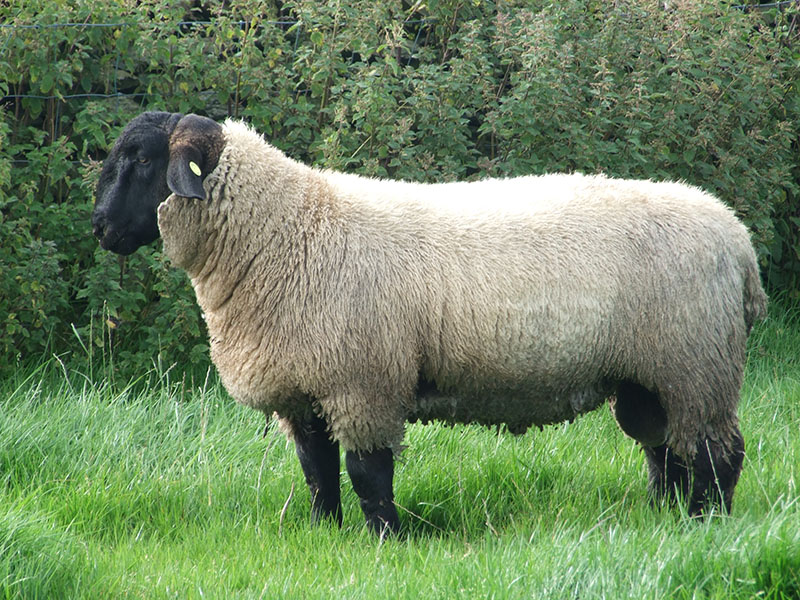Suffolk Sheep
The original Suffolks were the  result of crossing Southdown rams on Norfolk Horned ewes. Apparently the product of this cross was a great improvement over either one
of the parents. Although the Suffolk was a recognized breed as early as 1810, the
flock book was not closed until much later.
result of crossing Southdown rams on Norfolk Horned ewes. Apparently the product of this cross was a great improvement over either one
of the parents. Although the Suffolk was a recognized breed as early as 1810, the
flock book was not closed until much later.
In 1930, Southdowns were described as large sheep without horns, dark faces and legs, fine bones and long small necks. They were low set in front with high shoulders and light forequarters; however, their sides were good, rather broad in the loin, and were full in the thigh and twist. Today's Suffolk derives its meatiness and quality of wool from the old original British Southdown.
The Norfolk Horned sheep, now rare, were a wild and hardy breed. They were blackfaced, light, fleeced sheep. Both sexes were horned. The upland regions of Suffolk, Norfolk and Cambridge on the southeastern coast of England are very rugged and forage is sparse. It was this dry, cold and windy area in which the Norfolk breed adapted itself to traveling great distances for food, thereby developing a superbly muscular body.
 It was said at that time of the Norfolk Horned, "their limbs are long and muscular,
their bodies are long and their general form betokens activity and strength." This
breed and its crosses were valued highly both by farmers and butchers. However, sheepmen
of that day did not like the long legs, flat sides, nor wild nature of the Norfolk
Horned. They noted that Southdowns crossed with Norfolk produced a progeny that reduced
most of the criticisms of both breeds.
It was said at that time of the Norfolk Horned, "their limbs are long and muscular,
their bodies are long and their general form betokens activity and strength." This
breed and its crosses were valued highly both by farmers and butchers. However, sheepmen
of that day did not like the long legs, flat sides, nor wild nature of the Norfolk
Horned. They noted that Southdowns crossed with Norfolk produced a progeny that reduced
most of the criticisms of both breeds.
In 1886, the English Suffolk Society was organized to provide registry service and to further develop the use of the breed. Through selection and careful breeding by many great English sheepmen, the Suffolks brought to this country retained the qualities for which they were originally mated.
The first Suffolks were brought into this country in 1888 by Mr. G. B. Streeter of Chazy, New York. During a visit to England the previous year, Mr. Streeter had been greatly impressed by Suffolk sheep. These prize breeding animals had belonged to Joseph Smith of Hasketon, and one 21 month old ewe weighed exactly 200 lbs when she came off the ship. A 9 month old ram weighed 195 lbs and in the spring of 1890, a 7 week old twin weighed 85 lbs. That spring Streeter had a 200% lamb crop.
 Several leading sheepmen saw these sheep at the sale and they liked what they saw.
After several rounds of bidding, the ram was finally sold to Laidlaw and Brockie (developers
of the Panama breed) of Muldoon, Idaho, for $500. These men were so impressed with
the offspring from their Suffolk ram that they made several importations and were
consistent buyers at the National Ram Sales.
Several leading sheepmen saw these sheep at the sale and they liked what they saw.
After several rounds of bidding, the ram was finally sold to Laidlaw and Brockie (developers
of the Panama breed) of Muldoon, Idaho, for $500. These men were so impressed with
the offspring from their Suffolk ram that they made several importations and were
consistent buyers at the National Ram Sales.
Since that time, the University of Idaho has played a great part in developing and advancing the Suffolk in the western states.
Mature weights for Suffolk rams range from 250-350 lbs (113-159 kg), ewe weights vary from 180-250 lbs (81-113 kg). Fleece weights from mature ewe are between five and eight pounds (2.25-3.6 kg) with a yield of 50-62%. The fleeces are considered medium wool type with a fiber diameter of 25.5-33.0 microns and a spinning count of 48-58. The staple length of Suffolk fleece ranges from 2-3.5 inches (5-8.75 cm).
Breed Associations and Registries
United States
United Suffolk Sheep Association
PO Box 121
Holland, IA 50642
Phone: (641) 684-5291
Email: info@u-s-s-a.org
References
National Suffolk Sheep Association
Mason, I.L. 1996. World Dictionary of Livestock Breeds, Types and Varieties. Fourth Edition. C.A.B International. 273 pp.
Who's Who in U.S. Sheep Breeds(poster), American Sheep Industry Assn., Inc.; 6911 S. Yosemite St. Suite 200; Englewood, CO 80112-1414
Phone: (303) 771-3500 Fax: (303) 771-8200
